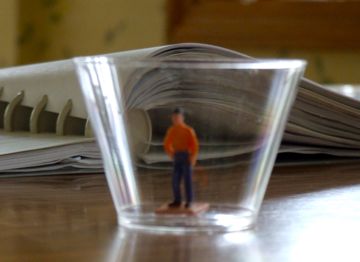Jon Scieszka and Lane Smith’s book, “Seen Art?”, starts this way:
It all started when I told my friend Art I would meet him on the corner of 5th and 53rd. I didn’t see him, so I asked a lady walking up the avenue, “Have you seen Art?”
“MoMA?” asked the lady.
“Uh…. no. He’s just a friend.”
“Just down the street in that beautiful new building. You can’t miss it.”…
But I didn’t see Art. I did see an official looking guy with a badge. “You seen Art?” I asked.
“MoMA?” said the guy.
I figured this might be a secret password. “Yes!”
“Your timing is perfect. We’re just opening.” The badge guy opened the door for me. I was in.
It should only be that easy! The boy goes on to discover that Art is more than just his friend’s name. He moves from gallery to gallery looking for Art and instead encountering paintings, sculptures, and things he can’t even recognize. When he finally finds his friend (I don’t want to ruin the ending for you), he is more than eager to share his experience.
The art of today begs to be seen. It begs to be walked into, over, and around (think Doug and Mike Starn). It begs to be examined up close… in person. But the fact of the matter is that students in grade school, college, even grad school, see art far more often in books and on screens than they do in person. As a matter of fact, a large majority of K-12 art educators all over the country take very, very few trips to see art in person with their students. Sometimes this has to do with access, sometimes it has to do with proximity, sometimes it has to do with policy, and sometimes it has to do with laziness. Regardless, it should come as no surprise that students learn a ton more when they experience actual works of art vs. looking at it on a screen. I dare say we can’t actually see (understand) art without being there. There’s a difference between looking and seeing. Seeing implies understanding. Teaching art without ever giving students the experience of seeing works of art in person, besides the ones they create themselves, is like an English teacher teaching only with excerpts and never the whole novel.
While students near big cities often have different opportunities to see art (and even look for their friend Art) in person, students in rural and suburban areas obviously have fewer opportunities to see art in museums, galleries, and public spaces. But in most places, regardless of where we live or teach, there are artists working that love to share their passion with students. We may not have MoMA right down the street, but we have local artists and the friends and colleagues of those local artists who are often are willing to share their expertise and give students firsthand experiences.
I would guess that most teachers, maybe as much as 95% of art educators across the country, take one trip per year with their classes. Many take none at all (again, for various reasons… I’m not trying to lay blame here). But the fact remains that as art educators, we must provide firsthand experiences however we can- either by getting out of the classroom or bringing artists’ works into the classroom for closer examination. Part of our work has become (continues to be?) about how to teach students to see and engage with art in ways that are not possible with a projected image on the screen.




